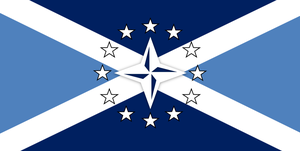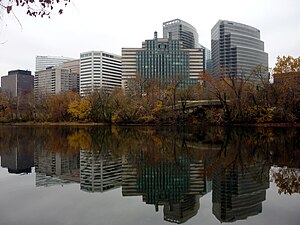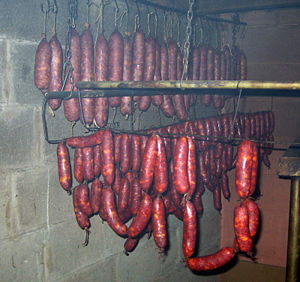Ventarya: Difference between revisions
No edit summary Tag: 2017 source edit |
No edit summary Tag: 2017 source edit |
||
| Line 63: | Line 63: | ||
===Colonisation=== | ===Colonisation=== | ||
Although [[Kiygrava]] was the first part of Great Kirav to be settled by Coscivians and [[Valēka]] was never rivalled as the island continent's economic core, the [[Míhanska Bay]] area (Ventarya and Hanoram) was the second part of the eastern seaboard where Coscivian colonies successfully took root. The first Coscivian settlements in what would become Ventarya were founded at X, Y, and Z by small companies of self-funded men, mostly drawn from among the gentry and minor nobility of Vrytha and northern Kórsa, most of whom belonged to Vexin Coscivian clans and brought Vexin cultural traditions to their new lands. | Although [[Kiygrava]] was the first part of Great Kirav to be settled by Coscivians and [[Valēka]] was never rivalled as the island continent's economic core, the [[Míhanska Bay]] area (Ventarya and Hanoram) was the second part of the eastern seaboard where Coscivian colonies successfully took root. The first Coscivian settlements in what would become Ventarya were founded at X, Y, and Z by small companies of self-funded men, mostly drawn from among the gentry and minor nobility of Vrytha and northern Kórsa, most of whom belonged to Vexin Coscivian clans and brought Vexin cultural traditions to their new lands. | ||
The colony developed a {{wp|manorialism|manorial}} economy based in large agricultural estates tended mostly by workers held in various forms of {{wp|unfree labour}} relations, including {{wp|indentured servitude}} and peonage, though over the course of Ventaryan history most unfree labourers were gradually converted into {{wp|sharecroppers}} and {{wp|copyhold|copyholders}}. | |||
The cultivation of these crops was a lucrative industry, and the Míhanska colonies quickly overtook Kiygrava in wealth and population. However, the decentralised and agrarian course of both colonies' development kept their populations largely dependent on Valēka and Old Coscivia for manufactures. | The cultivation of these crops was a lucrative industry, and the Míhanska colonies quickly overtook Kiygrava in wealth and population. However, the decentralised and agrarian course of both colonies' development kept their populations largely dependent on Valēka and Old Coscivia for manufactures. | ||
| Line 88: | Line 90: | ||
===Ethnosocial Groups=== | ===Ethnosocial Groups=== | ||
Ventarya was first settled by Coscivian colonists from the provinces of Vrytha (Thínorem and Taństem) and Kaltedan, and today the Thínorem, Southern Taństem, and Kaltem ethnosocial communities descended from these colonists remain the largest and most influential in the state. | Ventarya was first settled by Coscivian colonists from the provinces of Vrytha (Thínorem and Taństem) and Kaltedan, and today the Thínorem, Southern Taństem, and Kaltem ethnosocial communities descended from these colonists remain the largest and most influential in the state. | ||
The town of Konstanta in County Maddók is populated by people of [[Urcea|Urcean]] descent who immigrated from [PROVINCE] in the Xth century. | |||
==Economy== | ==Economy== | ||
Revision as of 01:00, 4 October 2020
| Grand Republic of Ventarya Lordakéarita Ventarya | |
 Flag | |
| Country | Kiravian Federacy |
| Capital | Méridatren |
| Largest city | Deneva |
| Population | 25,345,000 |
| Chief Executive | Íosevus Aldēmar (I) |
| Chancellor | Livyan Prātoverin (RP) |
| Stanora seats | 3 |
| Official languages | Thínoran Coscivian Kiravic Coscivian, High Coscivian |
| Postal Abbreviation | VEN |
Ventarya is a state of the Kiravian Federacy, located on the southeastern coast of Great Kirav in the Míhanska Bay region. Ventarya was the second area of Great Kirav to be colonised by the Coscivian Empire and the first state admitted to the Confederate Republics of Kiravia.
Geography
Ventarya borders Míhanska Bay and the Aquaric Ocean to the east, Hanoram and the District of Coīnvra to the north, Trinatria to the south, and Transateranda to the west. The Míhanska coast is heavily indented with peninsulae and estuaries fed by the state's numerous rivers. Most of eastern Ventarya is part of the southeastern Aquaric Coastal Plain, with the terrain beginning to rise in the middle portion of the state into the foothills of the Aterandic Mountains.
Temperate mixed forests are the dominant form of vegetation in Ventarya, though many parts of the southwest belong more properly to the South Kiravian Conifer Forests ecoregion dominated by slash pine and longleaf pine. With the contraction of the agricultural sector in recent decades, extensive reforestation has occured in the coastal and central portions of the state that were cleared for cultivation following Coscivian settlement.
Countyships and Cities
Central Ventarya
Federal Capital Region
Shafton Roads Metroplex
Míhanska Baylands
- Méridatren (state capital)
History
Colonisation
Although Kiygrava was the first part of Great Kirav to be settled by Coscivians and Valēka was never rivalled as the island continent's economic core, the Míhanska Bay area (Ventarya and Hanoram) was the second part of the eastern seaboard where Coscivian colonies successfully took root. The first Coscivian settlements in what would become Ventarya were founded at X, Y, and Z by small companies of self-funded men, mostly drawn from among the gentry and minor nobility of Vrytha and northern Kórsa, most of whom belonged to Vexin Coscivian clans and brought Vexin cultural traditions to their new lands.
The colony developed a manorial economy based in large agricultural estates tended mostly by workers held in various forms of unfree labour relations, including indentured servitude and peonage, though over the course of Ventaryan history most unfree labourers were gradually converted into sharecroppers and copyholders.
The cultivation of these crops was a lucrative industry, and the Míhanska colonies quickly overtook Kiygrava in wealth and population. However, the decentralised and agrarian course of both colonies' development kept their populations largely dependent on Valēka and Old Coscivia for manufactures.
Republican Revolution
The Early Republic
As the most populous Kiravian state from XXXXX to XXXXX, Ventarya played a major political role in the Early Republic, often finding itself in rivalry with Kiygrava for preëminence in the infant federation.
Decline and Resurgence
Government
Ventarya is a presidential republic within the Kiravian Federacy. The bicameral state legislature comprises a lower House of Burgesses and an upper House of Trustees. The House of Trustees includes one Trustee representing each of the state's countyships and free cities, and one for each of several university constituencies.
The governor of Ventarya bears the title of Prime Executive, as do the governors of Hanoram and Cascada. The Prime Executive is serves a single, non-renewable five-year term, and former Prime Executives may run again only after being out of office for ten years.
Local government
Local government in Ventarya is characterised by stronger countyship governments and weaker municipal governments, which is reflective of the lesser degree and later onset of urbanisation in the state.
Society and Culture
Population Centres
Almost two-thirds of the Ventaryan population is concentrated in its three largest metropolitan areas. The largest of these, the Kartika Metropolitan Area, spills over from the District of Coïnvra into southern Hanoram and northern Ventarya. The Ventaryan portion of the metro area has undergone rapid economic and demographic growth over the past two decades as the governmental, defence, ærospace, and information technology sectors have boomed.
-Shafton Roads
Ethnosocial Groups
Ventarya was first settled by Coscivian colonists from the provinces of Vrytha (Thínorem and Taństem) and Kaltedan, and today the Thínorem, Southern Taństem, and Kaltem ethnosocial communities descended from these colonists remain the largest and most influential in the state.
The town of Konstanta in County Maddók is populated by people of Urcean descent who immigrated from [PROVINCE] in the Xth century.
Economy



Ventarya has transitioned from a historically agrarian economy to one heavily invested in high-tech industry and services. While the cultivation of kalir, tobacco, and various industrial crops and the raising of hogs remain important sectors of the state's economy, they directly employ far fewer Ventaryans today than in the past.
Though located far from Kiravia's major high-tech corridors on the West Coast and the outer Valēka metropolitan area, a small but growing technology sector has taken root in Ventarya, drawing on human capital and investment generated by the state's universities and by federally-supported engineering and research initiatives near Kartika and various military bases.
The defence industry and the Kiravian Forces are major contributors to the Ventaryan economy. Many large defence contractors are headquartered or have offices located in the Ventaryan portion of the Kartika Metropolitan area. Leading Kiravian weapons manufacturer Tredagon Arms Foundry is based in the town of Tredagon on the Barrima River and operates facilities in Shafton Roads. The Shafton Roads area is home to Shafton Naval Harbour, the Kiravian Navy's largest base and main centre of operations in Great Kirav, as well as several smaller dockyards and other installations. There are twelve military reservations in Ventarya, including Fort Bódran (operational headquarters of the Kiravian Army Marine Corps), and Fort Rilvitren (home to the Kiravian Army Rangers).
Construction is a key source of employment in Ventarya, driven by the demand for new development in and around the state's growing cities as rising land values demand denser development in the counties adjacent to Kartika and the suburban and exurban halos surrounding Kartika and Deneva push outward into the countryside.
Gallery
 |
 |
 |
 |
 |
 |
 |
 |